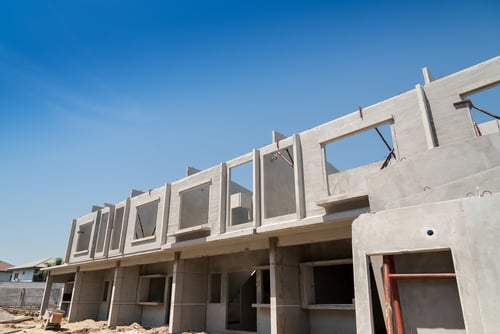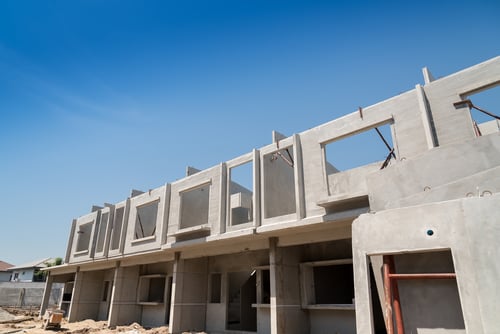Construction and manufacturing deliver a finished product through the transformation of raw materials. However, there are important differences: production focuses on large batches of identical products in controlled factory environments, while construction deals with one-off projects that are built in exposed locations. As a result, manufacturing wastes a reduced percentage of input materials and quality control is simpler.
Prefabrication is a very promising concept for building developers as it brings many benefits to manufacturing. Buildings are assembled from modular elements produced offsite, reducing the scope of work and labor hours on the project site. A controlled factory environment is also safer for the project team compared to an active construction site.
Optimize the construction process for your next construction project.
Prefabrication reduces costs and material waste
With a conventional construction process, all materials are delivered to the project site to be transformed into a building. However, this approach turns construction into an expensive process:
- Construction waste is often a mixture of materials, which is very difficult to separate for use in other projects. As a result, a large volume of construction materials ends up in landfills rather than in buildings.
- Quality control is more difficult at the project site compared to the factory floor. Some building materials are wasted due to misuse or damage – broken bricks and flooring are an example.
- Materials that come in predetermined shapes or sizes often must be cut before installation, and scraps are often wasted. For example, electrical conduit is purchased in 10' tubes, and a circuit that measures 28' will leave you with 2' of conduit. Unless another circuit requires exactly that amount, a piece of conduit will be wasted.
- Nails, screws, and other small construction materials easily fall onto project sites, especially when they are installed in hard-to-reach locations.
- Exposure to the elements can damage some construction materials.
- Because project sites are more exposed than a factory floor, there is also a constant risk of material theft.
Contractors can implement waste management practices, but some forms of waste are unavoidable even when materials are used efficiently. However, because prefabrication is carried out in a controlled factory environment, recycling and waste reduction are simplified.
When materials are used more efficiently, project costs are reduced proportionately. Prefabrication achieves greater cost efficiency by enabling automation in a factory environment, reducing the labor hours required on a project.
Prefabrication speeds up the construction process
When the entire construction process is completed outdoors, construction may be suspended due to external factors such as unfavorable weather conditions. However, this problem is minimized with prefabrication, as production can continue on the factory floor under any weather conditions.
Regardless of how a building will be used, rapid construction is always beneficial to the owner:
- Landlords who are currently renting a building can avoid paying rent.
- Even if clients use another building they own, it is free for rent or sale as soon as they move into the new building.
- If a project involves residential or commercial spaces for rent, a quick completion means the owner can receive rent payments sooner.
Prefabrication minimizes disruptions at the project site

Construction involves constantly moving heavy machinery and frequent deliveries of materials, while also producing a lot of noise. Additionally, material deliveries and truck movements can disrupt traffic when a project is located on a busy street.
By moving construction work off-site, prefabrication minimizes disruption to neighbors. Although modular components must be delivered to the project site, handling finished products is easier than working with basic materials.
Prefabrication achieves synergy with advanced design tools
3D modeling tools have a well-established role in manufacturing, but the concept is relatively new to the construction industry. Because prefabrication brings part of the construction process into a factory environment, it enables automated manufacturing methods based on digital component models. Machine tools controlled by CNC robots are a well-known example.
Building Information Modeling (BIM) can produce highly detailed documents and specifications, but meeting these requirements on an exposed construction site is a significant challenge. On the other hand, a controlled factory environment allows for better quality and greater precision.
Final Observations
There is a common misconception that a prefabricated building is more expensive than one built using traditional methods. It's true that prefabrication consumes large amounts of resources upfront, whereas material expenses are more evenly distributed throughout the project with traditional construction. However, when prefabrication is planned and implemented correctly, it reduces total project costs.
Prefabrication also involves a learning curve for project team members, who may be accustomed to decades of traditional construction methods. However, the work of supervisors and contractors is actually simplified with prefabrication. Consider that the design approach must be changed slightly as the building must be specified in terms of externally produced modular components.

